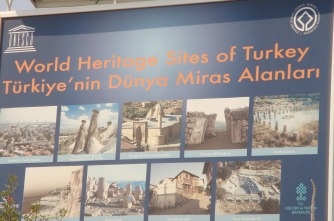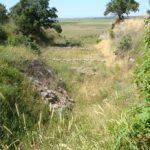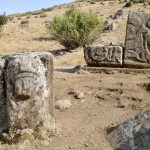If you’re planning a tour of Turkey you might want to factor in that these are the sites that UNESCO believes the world could not do without. Many others appear on the Tentative List of sites that may in due course be upgraded to world heritage status but are not quite there yet.
Historic Areas of İstanbul
No prizes for guessing that the old part of İstanbul enclosed within the Walls of Theodosius was one of the first places in Turkey to achieve world-heritage-site status. Attention focuses on the great monuments of Sultanahmet (Ayasofya, Topkapı Sarayı, Sultanahmet Camii (Blue Mosque), and the Yerebatan Sarnıcı (the Underground Cistern)) but also encompasses the magnificent Süleymaniye Camii and even the wooden houses of the back streets in areas such as Vefa.
Unfortunately Old İstanbul is now seen as in danger from population pressure, industrial pollution and uncontrolled urbanisation. In particular the restoration work on some stretches of the ancient walls has come in for much criticism.
Archaeological Site of Troy
Who hasn’t heard of Troy, the wondrous walled city made famous by Homer’s saga, The Iliad, and then brought to light, despite many people assuming it was as fantastical as Atlantis, by the German businessman-turned-archaeologist, Heinrich Schliemann? Some visitors to the site come away disappointed because the ruins can’t hope to compete in splendour with those of Ephesus or Aphrodisias. However, the site won its listing not just because of the cultural significance of The Iliad but also because it demonstrated one of the earliest contacts between the European world of the Mediterranean and that of Anatolia.
Diyarbakır Fortress and Hevsel Gardens
The walls of Diyarbakır are said to be visible from the moon although that is probably an urban myth. Regardless, they’re an impressive if somewhat grim sight, still enclosing the narrow streets of the old heart of what is now a large and largely modern town. So dominant are they that the area within the walls is called simply Sur (Walls). The Hevsel Gardens stretch from the walls down to the banks of the Tigris, a sea of greenery in contrast to the black basalt. They had been threatened with development. Hopefully their listing in 2015 will have seen off that threat.
Turkey’s biggest and best-known archaeological site was a late addition to the list, only being added to it in 2015. The crowds can be oppressive here, especially in summer, but if you do manage to come at a relatively quiet time you can hardly fail to be impressed, especially by the Terraced Houses, dating back to the 1st century AD, where you can even go upstairs inside houses that have been excavated to reveal frescoed walls and mosaic-covered floors.
Hierapolis-Pamukkale
Most visitors to Turkey will be familiar with images of Pamukkale, near Denizli in Western Anatolia, where calcium-laden water flowing over a cliff-edge has created beautiful white travertines, petrified waterfalls with pools of warm water collected on top of them. A site as amazing as this attracted attention from earliest times, and King Eumenes II of Pergamum established a spa resort here in 190 BC which was expanded into Hierapolis, a sprawling hillside city, by the Greeks and Romans. Unfortunately in the rush to get to the travertines the extensive remains, which include a vast necropolis and a lengthy stretch of original Roman pavement, often get overlooked.
These two sites on the south coast between Fethiye and Patara are reminders of a time when the Lycians ruled this part of the coast from their capital at Xanthos, a little inland from Kınık. Originally Xanthos was adorned with wonderful pillar carvings some of which were removed to the British Museum in 1842. The Letoon lies closer to the sea and was originally a shrine to Leto, a lover of Zeus, and her son Apollo and daughter Artemis. Frequently flooded, it is a serene and peaceful place to escape the summer crowds.
Routinely dubbed “the Eighth Wonder of the World”, Nemrut Daği, the great burial site of Antiochus I (69-34 BC) on top of a mountain between Malatya and Adıyaman in the southeast, crops up on posters all over the country which depict the giant heads of eagles, lions and men that ringed the mound before they were toppled by an earthquake. It’s a great place to visit especially if you opt to do so in the middle of the day to avoid the dawn and sunset crowds. It’s also the only one of Turkey’s world heritage sites that requires some physical exertion to appreciate. Bring sturdy shoes.
Göreme and the Rock Sites of Cappadocia
Göreme was not just one of the first sites to be listed but is also an example of somewhere that is regarded as equally important not just for the natural beauty of a landscape created by the action of wind and rain on soft volcanic tuff but also for the cultural importance of its endless rock-cut churches, chapels and underground cities. Within the wider site it is Göreme Open Air Museum that has the main honour of showing off the world heritage site symbol and that’s because the small churches contained inside it provide important evidence of the development of provincial Byzantine art in the post-Iconoclastic period.
Hattuşa: the Hittite Capital
Hidden in the countryside near Çorum, north-east of Ankara, Hattuşa is an enormous site where recent reconstruction has arguably made it easier for non-experts to appreciate what they’re seeing while irritating the purists at the same time. The site dates back to the second millennium BC when the Hittites ruled a huge swathe of Central Anatolia. Images of the gods they worshipped line up in a narrow gully at nearby Yazılıkaya.
Great Mosque and Hospital of Divriği
The least known and hardest to visit of all Turkey’s world heritage sites is the elaborate complex built in 1228-29 for Ahmed Şah in Divriği, some three hours’ drive east of Sivas in a town that lacks a decent hotel. Sivas itself boasts several fine examples of Selçuk architecture in which almost all the decorative effort is focused on the soaring entrances but in Divriği that decorative enthusiasm was taken to a whole different level in carvings that all but jump out from the walls. This is one for die-hard architectural enthusiasts but is none the less remarkable for that.
City of Safranbolu
Many people traveling between İstanbul and Ankara choose to break their journey in Safranbolu which contains the most undamaged 19th-century urban landscape in Turkey. Here you can not just admire the wonderful old Ottoman houses spreading out from the cute little Arasta bazaar but also stay in some of them too as many of the finest houses have been turned into hotels complete with all sorts of hidden quirks such as lounges set up in what were once the stone strong rooms in which people stored their wheat and valuables.
Selimiye Cami, Edirne
The Süleymaniye Cami in İstanbul may be better known but it was the 16th-century Selimiye Cami in Edirne that the great Ottoman architect Sinan himself regarded as his masterpiece, a choice with which many architectural enthusiasts concur. Coming to see for yourself will also give you an excuse to explore one of Turkey’s more attractive small towns.
Neolithic site of Çatalhöyük
Not far from Konya, this world heritage site is more important for what it has had to tell archaeologists than for anything especially dramatic to see at the site itself. But, like Troy, Çatalhöyük has a resonance much louder than the rather disappointing structures uncovered. Many people associate it with the idea of a Mother Goddess even though the evidence for this is ambiguous at best. Come here if you like to dream of the very distant past.
Pergamum and its Multi-Layered Cultural Landscape
The ruins of ancient Pergamum at Bergama were long overdue for inclusion on the WHS list although they are by no means as visited as they deserve to be. Come here to visit the remains of what was once a hugely important medical shrine in the town where parchment was invented and to take a look at the slight remains of the great Altar of Zeus now mostly housed in the Pergamum Museum in Berlin.
Bursa and Cumalıkızık: The Birth of the Ottoman Empire
Keen fans of Ottoman history will want to head east of İstanbul to visit Bursa, the first capital of the Ottoman Empire in the days of Osman and Orhan Gazi, and a city dotted with medieval mosques quite unlike the better-known – and later -Sinan models. In the outskirts, the village of Cumalıkızık is a mini-Safranbolu of crumbling wooden houses and a popular destination for leisurely brunches alongside Bursalı locals.
Archaeological site of Ani
Far out beyond Kars and overlooking what is now the Republic of Armenia, the walls of medeval Ani enclose the remains of the capital of the Armenian Bagratid kingdom that flourished in the 10th and 11th centuries. Ruined churches show off a style of architecture that is entirely Armenian while some of the churches still contain vivid frescoes. For many, the location of the site on a headland surrounded by ravines, will be almost as memorable as the ruins.
Deep in the heart of Western Anatolia, Aphrodisias runs Ephesus a close second in the extent of its surviving Roman-era ruins. Particularly striking is a stadium that remains almost intact. The small museum contains the magnificent carvings that once adorned the Sebasteion, a temple to the emperors as deities.
In the south-east of Turkey near Şanlıurfa, Göbeklitepe and the similar sites that have since been uncovered in the vicinity have tended to edge Çatalhöyük out as poster children for Turkish prehistory. Here were discovered extraordinary T-shaped pillars, some of them carved with decoration, inside a circular “temple” dating back to the 10th century BC. Much still remains to be discovered here but a visitor centre now provides some insight into the latest interpretation of the site.
Arslantepe Mound
Near Malatya in south-eastern Turkey, the Arslantepe mound is a tell on a site that has been inhabited from c.4,000BC right through to Hittite times. Excavations here have revealed a palace, adobe houses and burials, all of them beautifully displayed to the public.
Gordion
West of Ankara, Gordion was the site of the Phrygian capital. The city itself has been partially excavated but most people will be more interested in the tumuli that covered the graves of the Phrygian kings, including King Gordias who founded the city. A small museum at the site offers clues to Phrygian culture although the most important finds are on display in the Anatolian Civilisations Museum in Ankara.
Wooden hypostyle mosques of Medieval Anatolia
In 2023 a group of especially beautiful mosques in Western Anatolia acquired world heritage status. Externally built of stone, they all boast magnificent wooden interiors, their ceilings held up by rows of wooden pillars that have given them their nickname, the ‘forest mosques’. The mosques are the Aslanhane Cami in Ankara, the Ulu Cami in Afyon, the Eşrefoğlu Cami in Beyşehir, the Ulu Cami in Sivrihisar and the village mosque at Kasaba, near Kastamonu, the most difficult of them to get to.
Tentative World Heritage List
These are the places that appear on Turkey’s tentative world heritage list and are likely to be elevated to full world heritage site status over the coming years:
Adapazarı, Justinian’s Bridge
Amasya, Pontic Tombs
Ancient Cities of Lycia
Ankara, Hacı Bayram Cami area
Aspendos theatre and aqueduct
Ayvalık Industrial Landscape
Bodrum Castle
Kızılırmak Delta and Kuş Cenneti
Mamure Castle, nr Anamur
Nusaybin, Zeynel Abidin Cami and Mor Yakup Kilise
Sardis and the Bin Tepe tumuli
Selçuk medreses of Konya, Kayseri, Sivas, Erzurum and Kırşehir
Titus and Vespasian Tunnel, Çevlik
Trading posts and fortifications on Genoese trade routes from the Mediterranean to the Black Sea (Yoros Kalesi, Galata Tower, Eski Foça Kalesi, Çandarlı Kalesi, Amasra Kalesi, Akçakoca Kalese, Sinop Walls)
Tur Abdin churches and monasteries
Tuz Gölü (Salt Lake)
Zerzevan Castle and Mithraeum
Intangible Cultural Heritage
Flatbread-making
Nevruz celebrations
Mesir Macunu Festival in Manisa
Turkish coffee-making
Cermonial keşkek-making
Ebru, the art of marbling
Oil-wrestling at Kırkpınar
Alevi-Bektaşı semas
Meddah, public story-telling
Hüsn-i Hat, calligraphy
Turkish archery
Miniature painting
Whistled languages
Sohbet meetings
Mother-or-pearl inlaying
Crafting and performing balaban or mey
Manuscript illumination
Traditional methods of olive cultivation
Iftar
Sericulture
Ahlat stonework
Çay culture
Anecdotes of Nasreddin Hoca
Mangala/Göçürme game
Dede Korkut tradition
Hıdrellez
Çini-making
Aşıklık
Karagöz


